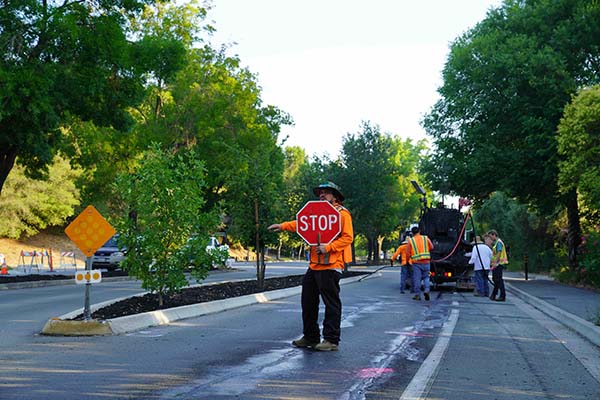Maintaining Lafayette’s Roads
LAFAYETTE, CALIF. / AGILITYPR.NEWS / November 02, 2024 / “Without ongoing maintenance, our streets are going to cost more to repair in the future…,” says Mike Moran, Director of Engineering and Public Works for the City of Lafayette.
Lafayette, Calif. – In 1995, Lafayette’s public roads and drains were in poor condition. The City had been incorporated for more than 25 years, and little maintenance had been done due to limited funds. After investigating funding sources, the City Council asked voters to approve a bond measure to fund the improvement of the roads. Lafayette City Manager Niroop K. Srivatsa said, “The measure, which was approved by voters in 1995, was meant to provide $13 million to improve Lafayette’s main roads and arterials.”
The bond measure initially levied a property tax assessment of $21 per $100,000 of assessed value for all Lafayette properties. The tax to repay the bonds has decreased steadily over the last 30 years, from $21 per $100K to just over $4 per $100K in 2024. The bonds will be completely paid off in 2025, and then the assessment will no longer be collected,” says the City Manager.
“After voters passed the bond measure three decades ago, Lafayette used both money from the bonds as well as from the General Fund to bring up the Pavement Condition Index (PCI) to an average of 76 in 2019. However, our current PCI has dropped to a current rating of 72 because of insufficient revenue assigned to street maintenance for the last four years. The PCI is a rating that goes from 0 to 100, putting the average PCI of 72 for Lafayette’s public roads in the category of “good condition.”
“It took us more than two decades to attend to every street in Lafayette with repaving or just surface seal if the street was in okay condition, but in some cases, we had to do complete reconstruction,” said Mike Moran, the Director of Engineering and Public Works.
There is a lot that goes into maintaining our streets. In addition to filling potholes, road maintenance also includes repairing streets, curbs, sidewalks, gutters, storm drains, trees, as well as shrub pruning and weed abatement within the public right-of-way and on City property. As part of some of the road rehabilitation projects, we also installed new storm drain systems where needed, and bypassed or removed old storm drain pipes. As a result, we significantly decreased flooding in the City,” Moran continues.
“The money provided by the 1995 bond measure enabled the City to raise the average PCI into good condition, but it was only a start. Additional revenue is required every year to maintain this infrastructure, and the costs increased significantly after Covid,” said Moran.
Moran continues, “We have most of the streets up to par now, especially compared to neighboring cities; however, without ongoing maintenance, our streets will ultimately cost more to repair. You can think of it like this: If you don’t replace the oil in your car regularly, you probably won’t notice a significant difference in performance for a while. At some point, it will cost a lot more to fix the engine than to have oil changes consistently.”
According to Srivatsa, while the current budget provides funding this fiscal year to address the Council’s primary goals, the structural deficit and ongoing cost increases discussed above continue to put pressure on the City’s finances. In the last three years, the cost of maintaining Lafayette’s 92 miles of public roads has increased by $1M a year due primarily to a 33% increase in the cost of contracted labor and materials.
Presently, the money available for street pavement maintenance is approximately $2.5 million annually, while the cost to maintain our roads in their current condition is expected to be $3.7 million annually.
The City Council has placed Measure H, the Lafayette Sales Tax Measure, on the November 5, 2024, ballot so that Lafayette voters can consider enacting a local sales tax of ½ cents for seven years to provide funding to maintain the current level of City services.
If authorized, Measure H will generate approximately $2.4 million annually for City services. ll funds generated by the sales tax will be locally controlled and remain in Lafayette to provide City services. y law, the state cannot take this funding away, and the City is not required to share this money with any other government organization.
More information about Measure H is available on the City of Lafayette’s website at www.LoveLafayette.org/MeasureH or email lafayettelistens@lovelafayette.org.
Lafayette is a charming small community located in Contra Costa County, 30 miles from The City of Oakland. It's known for its beautiful green hills, excellent schools, and miles of hiking trails, making it an attractive place to live. The City has a population of more than 25,000 highly educated residents, with 75.2% of them holding a bachelor's degree or higher. Additionally, 73.6% of the homes in Lafayette are owner-occupied. The median home value is $1,914,700, while the median household income is $219,250. The total area of the city is 15.22 square miles.

The cost of maintaining Lafayette’s 92 miles of public roads has increased by $1M a year.
Contacts
tracy Robinson
Administrative Services Director
TRobinson@ci.lafayette.ca.us3675 Mount Diablo Blvd., #210 Lafayette CA 94549
Phone: (925) 299-3227
lovelafayette.org